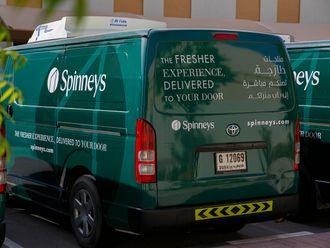London
The pound rose to a one-year high against the dollar after UK inflation accelerated more than forecast, prompting investors to bring forward expectations for an interest-rate increase by the Bank of England next year.
Sterling strengthened against all of its Group-of-10 counterparts after UK legislation to withdraw Britain from the European Union passed its first parliamentary hurdle, and data showed consumer prices rose an annual 2.9 per cent in August. That was more than the 2.8 per cent median economist estimate in a Bloomberg survey and July’s 2.6 per cent reading.
The release comes as BoE officials meet ahead of their policy decision on Thursday. While the Monetary Policy Committee is seen holding its key interest rate at a record-low 0.25 per cent this week, rate markets are now pricing in a one-in-three chance of a rise by the end of the year, compared with one-in-five a week ago. Money markets are pricing a full 25-basis-point rise for its August 2018 meeting, based on Sonia fixings.
The inflation data “are going to continue providing support to the pound ahead of the BoE this Thursday,” said Stephen Gallo, an analyst at BMO Capital Markets. “While not good for the UK consumer, sterling positioning is still short, the dollar is weak and these numbers could have a material impact on the tone of the MPC discussions.”
The pound strengthened as much as 0.9 per cent to $1.3282, touching its highest since Sept. 15, 2016. It rose as much as 0.9 per cent against the euro, gaining for a third day.
Hawkish Hopes
Expectations for the BoE to hike rates at this week’s meeting are low, according to interest-rate futures, which show just a 7 per cent probability of an increase, up from 5.3 per cent before the data.
The pound’s 11 per cent drop against the dollar since the Brexit referendum is feeding through to prices for household items, with inflation never higher since 2012.
“We were expecting continued deceleration of price pressures into year-end, but pass-through from the weaker sterling may be having lingering effects here,” said Gallo. Every single category increased from July, “with transport, communication, household goods and clothing all showing material increases.”
After the data, a flurry of activity occurred in short-sterling options that would pay off if the bank raises rates at this week’s meeting.
Sterling had already risen ahead of the data on expectations of the BoE to turn more hawkish, according to Rabobank’s Jane Foley. Just two of the nine members of the committee voted to increase interest rates last month, but some economists see a third — Andy Haldane — joining them at this meeting.
“Some re-adjustment of positions has been taking place in sterling in case Haldane comes out as a hawk this month,” Foley said.
Rising food prices push India’s August retail inflation to five-month high
India’s consumer price inflation rose more than expected to a five-month high in August, fuelled by strong gains in prices of food items, dampening chances of a rate cut by the central bank in a policy review next month amid weak economic growth. India’s consumer price index (CPI) rose 3.36 per cent in August from a year earlier, data released by the Ministry of Statistics on Tuesday showed. Analysts polled by Reuters had expected CPI inflation would edge up to 3.20 per cent, compared with 2.36 per cent in July.
Last month, the Reserve Bank of India (RBI) cut its main policy rate by 25 basis points to 6 per cent, the lowest since 2010, while keeping its policy stance at “neutral”.
Analysts said a rise in inflation for two straight months has reduced the chances of another rate cut by the Reserve Bank of India, which has a central inflation target of 4 per cent.
— Reuters












